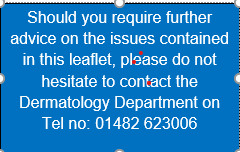- Reference Number: HEY1299/2022
- Departments: Dermatology
- Last Updated: 31 May 2022
Introduction
This leaflet has been produced to give you general information. Most of your questions should be answered by this leaflet. It is not intended to replace the discussion between you and the healthcare team, but may act as a starting point for discussion. If after reading it you have any concerns or require further explanation, please discuss this with a member of the healthcare team.
What is a Patch Test?
You have probably been troubled by some symptoms and following discussion with your doctor a patch test has been arranged. Patch tests establish if you have any allergies to things you come into contact within the environment, for example in creams, washing products, dyes and many more items.
You will be tested with a number of substances most common in contact allergy. These include: perfumes, metals, preservatives and rubber. Extra patch tests may have been arranged by the doctor, depending on your skin problem.
The different substances are placed in hypoallergenic adhesive patches which are applied to your back. The substances remain in place for five days and you can then be assessed for allergic reactions.
Why do I need Patch Testing?
Patch testing is a way to find out if you are allergic to anything that is coming into contact with your skin. The symptoms you have been having mean this may possibly be the cause. If the tests are positive, then you will know what substances to avoid in the future. However, we cannot patch test all substances, so you will still need to monitor your skin and do your own research. Also, allergies can change over time.
Some people prefer to avoid certain substances, if they know they cause a problem and do not feel testing is required. However, for some people the tests identify a substance which they were not aware of and can monitor in the future.
Can there be any complications or risks?
Patch testing is not advisable if you:
- have a widespread rash on your back
- are pregnant or breastfeeding
- have had sun exposure or used a sun bed in recent weeks
- are taking immunosuppressant medication. Some may be acceptable, however, please discuss this with your Doctor or Nurse
- are taking oral steroids. Some doses may be acceptable, please discuss this with us before stopping any medication.
If any of these apply, please contact one of the nursing staff.
Side effects are uncommon, but may include:
- ongoing reaction: a very small number of reactions may persist for up to a month.
- sometimes substances may temporarily stain the skin.
- skin colour change: colour may increase or decrease at the site.
- allergy: very rarely, you may become sensitive / allergic to one of the test products.
- flare up of a skin condition: positive reactions can trigger a flare.
- infection or scarring: these are rare.
- rarely, severe reactions can produce small ulcers on the skin, which require topical treatment.
How do I prepare for the Patch Tests?
Please read the information leaflet. Share the information it contains with your partner and family (if you wish) so that they can be of help and support. There may be information they need to know, especially if they are taking care of you following this examination.
Creams and ointments applied to your back should be avoided for 24 hours prior to patch testing.
It is advisable to trim any excess hair on the upper back area 24 hours before having your patch tests applied as this helps them remain more secure. Ideally, you should not shave your back.
What will happen?
Three visits to hospital are required.
First visit: Monday. Allow up to one hour for this visit when small quantities of the test substances will be applied to your back. They are held in special chambers, covered by hypoallergenic tape and will be left in place for 48 hours. Please contact us if you have previously reacted to medical adhesive tapes or plasters. The locations of the chambers are marked on your skin with washable ink. Sometimes the arms or thighs are also used.
Second visit: Wednesday. First we will take a picture of the location of the patch tests on your back, using your phone, if this is agreeable to you. This is to help the Doctor identify any allergy sites, on the Friday visit. The chambers are then removed and any reactions recorded. The nurse will re-mark the sites with ink. Please continue to keep the areas dry and apply no creams, or ointments, until after your third visit 48 hours later.
Third visit: Friday. Your back will be examined for any reactions. Red and itchy skin will occur with positive reactions, which will usually be visible for reading by the doctor on the Friday visit. Occasionally late reactions may appear, up to 10 days after application, please contact the clinic in this case. Most reactions will disappear after a few days. The doctor will discuss any positive reactions with you and relevant information will be provided.
If your patch tests are negative no changes will occur on your skin, such as redness / itching, where the patches were applied. This helps in your diagnosis in that contact allergy may not be the cause of your skin problems.
Frequently Asked Questions
Can I bathe or shower during this week? No, if you wash the pen or substances off, the tests will not work. You need to keep your back completely dry until after the third visit, but you can wash other areas. It is advisable to have a shower or bath prior to your first visit.
Should I wear special clothing? The pen may mark clothing (or your sofa / bed sheets etc.). The pen can mark your skin and may take a short length of time to wear off. It may be beneficial to wear old clothing. It may be preferable to wear an old t-shirt or vest in bed, as this will prevent the patches coming off.
Can I carry on as normal during the test week? Try to avoid excessive bending and twisting or strenuous exercise, as the patches may come off. Do not go swimming. Take care for the first two or three hours after application. This is when the patches are most likely to come off. Do not expose your patch sites to the sun (or sun beds) during this week.
What happens if I feel the patches are coming off? If one of the patches becomes loose, please secure it with the tape provided.
Are Patch Tests painful? The patches may feel a little strange and tight. Some itching is normal, but if it becomes severe, the patch tests may need to be removed. Should this occur, please contact us.
What will happen afterwards?
After your assessment and results on the Friday, all patients can return to their normal daily living activities. Remember to look out for late reactions, up to 10 days after application.
Your individual symptoms and results will determine your treatment path from this point. Some patients will be discharged, some will have further patch tests and others may need other investigations or treatment. This will be discussed with you at your appointment on the Friday.

This leaflet was produced by the Dermatology Department, Hull University Teaching Hospitals NHS Trust and will be reviewed in May 2025.
General Advice and Consent
Most of your questions should have been answered by this leaflet, but remember that this is only a starting point for discussion with the healthcare team.
Consent to treatment
Before any doctor, nurse or therapist examines or treats you, they must seek your consent or permission. In order to make a decision, you need to have information from health professionals about the treatment or investigation which is being offered to you. You should always ask them more questions if you do not understand or if you want more information.
The information you receive should be about your condition, the alternatives available to you, and whether it carries risks as well as the benefits. What is important is that your consent is genuine or valid. That means:
- you must be able to give your consent
- you must be given enough information to enable you to make a decision
- you must be acting under your own free will and not under the strong influence of another person
Information about you
We collect and use your information to provide you with care and treatment. As part of your care, information about you will be shared between members of a healthcare team, some of whom you may not meet. Your information may also be used to help train staff, to check the quality of our care, to manage and plan the health service, and to help with research. Wherever possible we use anonymous data.
We may pass on relevant information to other health organisations that provide you with care. All information is treated as strictly confidential and is not given to anyone who does not need it. If you have any concerns please ask your doctor, or the person caring for you.
Under the General Data Protection Regulation and the Data Protection Act 2018 we are responsible for maintaining the confidentiality of any information we hold about you. For further information visit the following page: Confidential Information about You.
If you or your carer needs information about your health and wellbeing and about your care and treatment in a different format, such as large print, braille or audio, due to disability, impairment or sensory loss, please advise a member of staff and this can be arranged.

